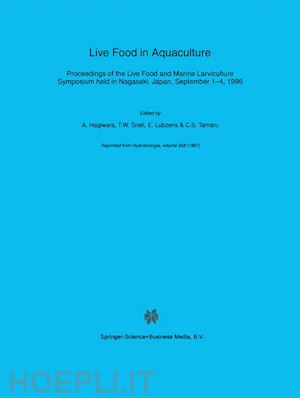The status of marine fish larval-rearing technology in Australia.- Development and achievements of marine fish-rearing technology in France over the last 15 years.- Mariculture in Israel — past achievements and future directions in raising rotifers as food for marine fish larvae.- Present status of larval-rearing technology in Korea.- Larval-rearing technology of marine species in Norway.- Collection and culture of live foods for aquaculture in Taiwan.- Status of marine larviculture in Thailand.- Marine finfish hatchery technology in the U.S.A. — status and future.- Effects of asexual reproduction on the neighborhood area of cyclical parthenogens.- Speciation in monogonont rotifers.- Comparative binding of antibody to a mate recognition pheromone on female Brachionus plicatilis and Brachionus rotundiformis (Rotifera).- Nitrogen-flow in the rotifer Brachionus rotundiformis and its significance in mass cultures.- Energy content of rotifers (Brachionus plicatilis and Brachionus rotundiformis) in relation to temperature.- Some properties of ?-1,3-glucan hydrolyzing enzymes from the rotifer Brachionus plicatilis.- Ultrastructure of the rotifer Brachionus plicatilis.- Genetic variation among marine Brachionus strains and function of mate recognition pheromone (MRP).- Effect of some vertebrate and invertebrate hormones on the population growth, mictic female production, and body size of the marine rotifer Brachionus plicatilis Müller.- Interspecific interactions in the marine rotifer microcosm.- Algae and rotifer turbidostats: studies on stability of live feed cultures.- Application of unicellular algae Chlorella vulgaris for the mass-culture of marine rotifer Brachionus.- Recent development of a high density mass culture system for the rotifer Brachionus rotundiformisTschugunoff.- Development of a continuous culture system for stable mass production of the marine rotifer Brachionus.- Preliminary results in improving essential fatty acids enrichment of rotifer cultured in high density.- Lipid and fatty acid content in cultivated live feed organisms compared to marine copepods.- Preservation of resting eggs of the euryhaline rotifer Brachionus plicatilis O.F. Müller by canning.- Temperature conditions enhancing resting egg production of the euryhaline rotifer Brachionus plicatilis O.F. Müller (Kamiura strain).- Live food production using batch culture and chemostat systems in Kuwait.- Infectious diseases affecting mass production of the marine rotifer Brachionus plicatilis.- Stimulative and inhibitory effects of bacteria on the growth of microalgae.- The potential of freshwater Anostraca for technical applications.- Culturing the fairy shrimp Streptocephalus dichotomus Baird using livestock waste — a reclamation study.- Effect of algal addition on stability of fatty acids in enriched Artemia franciscana.- A study of the freshwater rotifer B. calyciflorus in Pekanbaru, Riau, Indonesia.- Optimum medium for large-scale culture of Tetraselmis tetrathele.- Application of a growth-promoting bacteria for stable mass culture of three marine microalgae.- Semi-mass culture of the dinoflagellate Gymnodinium splendens as a live food source for the initial feeding of marine finfish larvae.- Culture of Tetraselmis tetrathele and its utilization in the hatchery production of different penaeid shrimps in Asia.- Continuous culture with deep seawater of a benthic food diatom Nitzschia sp..- Protein and lipid content of the rotifer Brachionus plicatilis during variable growth and feeding condition.- Preliminary investigation of feeding performanceof larvae of early red-spotted grouper, Epinephelus coioides, reared with mixed zooplankton.- Essential fatty acid profiles of maturation feeds used in freshwater ornamental fish culture.- Use of the rotifer, Brachionus calyciflorus Pallas, in freshwater ornamental fish larviculture.- Studies on the factors influencing larval settlement in Balanus amphitrite and Mytilus galloprovincialis.- Induction of larval metamorphosis in the sea cucumber Stichopus japonicus by periphitic diatoms.- The concept of biological control methods in aquaculture.- Biocontrol method in aquaculture for rearing the swimming crab larvae Portunus trituberculatus.- Preliminary results on the effects of salinity and settling conditions on megalopal metamorphosis of fiddler crab Ilyoplax pusilla.- Preliminary results of providing various combinations of live foods to grouper (Epinephelus coioides) larvae.- Characteristics of Palinurids (Decapoda; Crustacea) in larval culture.- Effects of feeding of ß-carotene-supplemented rotifers on survival and lymphocyte proliferation reaction of fish larvae (Japanese parrotfish (Oplegnathus fasciatus) and Spotted parrotfish (Oplegnathus punctatus)): preliminary trials.- Role of Godavari mangroves (India) in the production and survival of prawn larvae.- Larval-rearing and growout of the red porgy (Pagrus pagrus) in the Riopesca hatchery (Greece).- Author Index.











